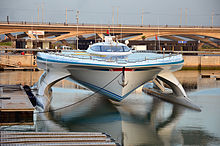
An electric boat is a powered watercraft driven by electric motors, which are powered by either on-board battery packs, solar panels or generators.[1]
While a significant majority of water vessels are powered by diesel engines, with sail power and gasoline engines also popular, boats powered by electricity have been used for over 120 years. Electric boats were very popular from the 1880s[2] until the 1920s, when the internal combustion engine became dominant. Since the energy crises of the 1970s, interest in this quiet and potentially renewable marine energy source has been increasing steadily, especially as more efficient solar cells have become available, for the first time making possible motorboats with a theoretically infinite cruise range like sailboats. The first practical solar boat was probably constructed in 1975 in England.[3] The first electric sailboat to complete a round-the-world tour (including a transit of the Panama Canal) using only green technologies is EcoSailingProject.
One of the main benefit of shift to electric from fossil fuelled boats apart from environmental benefit is the low cost of operation. This can be understood if we assess the cost of mechanical energy from different sources - diesel engine, grid energy stored in battery to motors, adding solar to the grid energy stored in battery to motors. The spread between the diesel engine and the other two is dependent on fuel cost and grid cost in the respective region. but in a place like India this could be factor or ten.[4]
- ^ Sandith Thandasherry (10 July 2021). Solar Electric Boats: Plan, Build and Benefit. Emerging Technology News.
- ^ Cite error: The named reference
thames_mapwas invoked but never defined (see the help page). - ^ Electrical Review. 201 (7). 12 August 1977.
{{cite journal}}: Missing or empty|title=(help) - ^ Sandith Thandasherry (2023): Technology choices of a medium speed electric ferry. Research gate 20.Aug.2023.